Terada Katsuya
Join us as we go behind the scenes of manga creation with world-famous artist Terada Katsuya as he works on the highly anticipated full-color entry in his Saiyuki Daienou series.
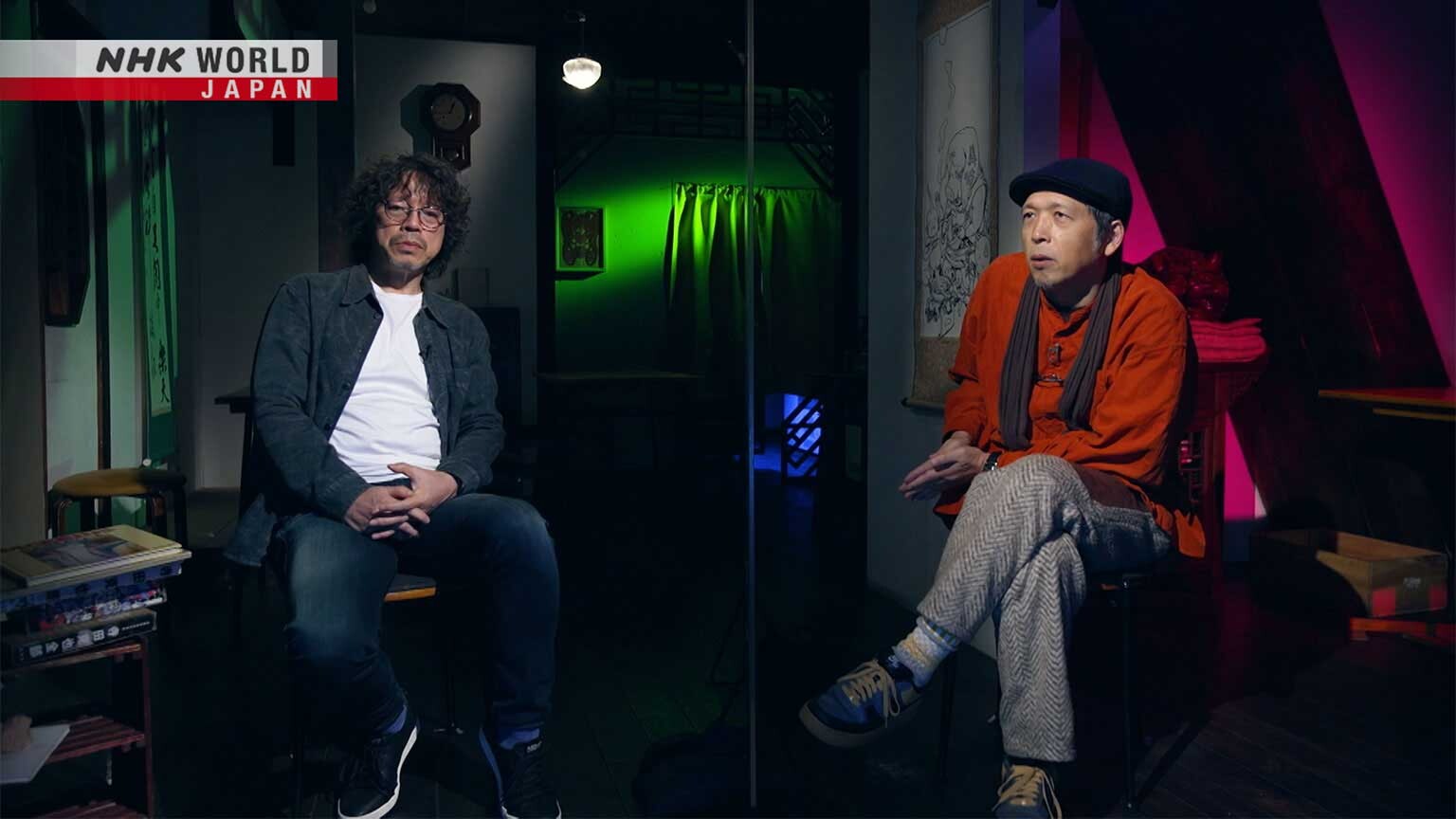
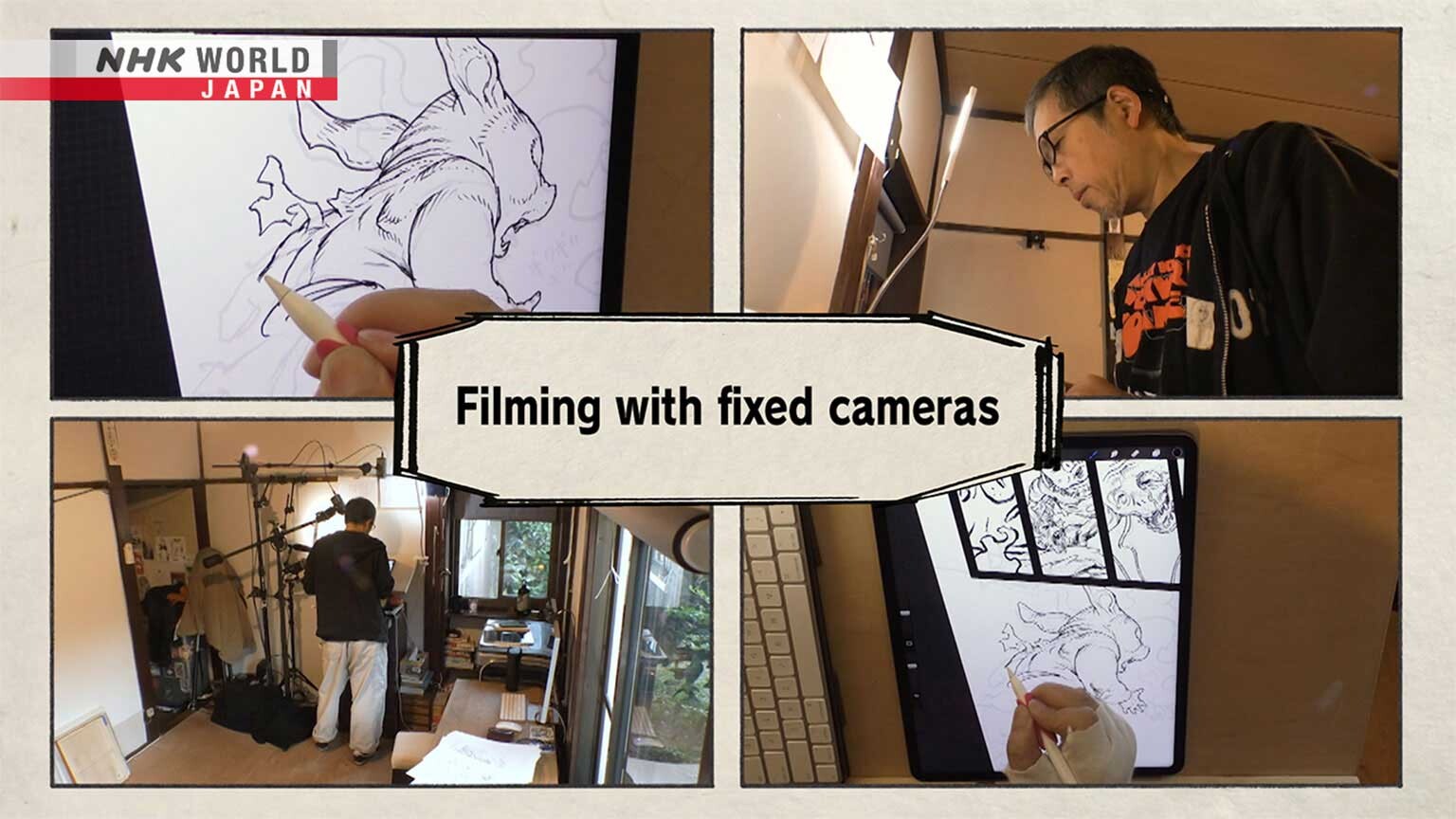
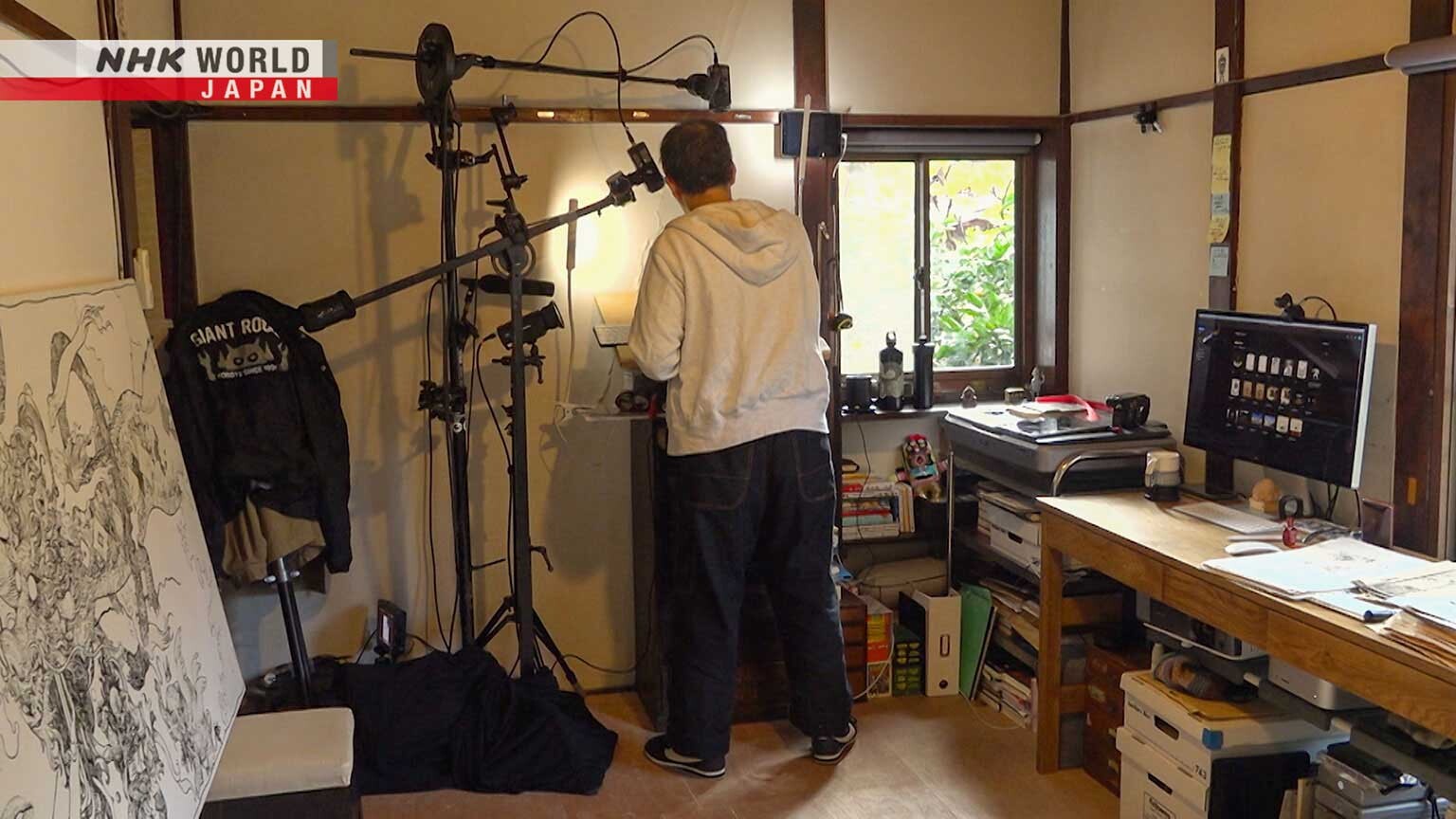
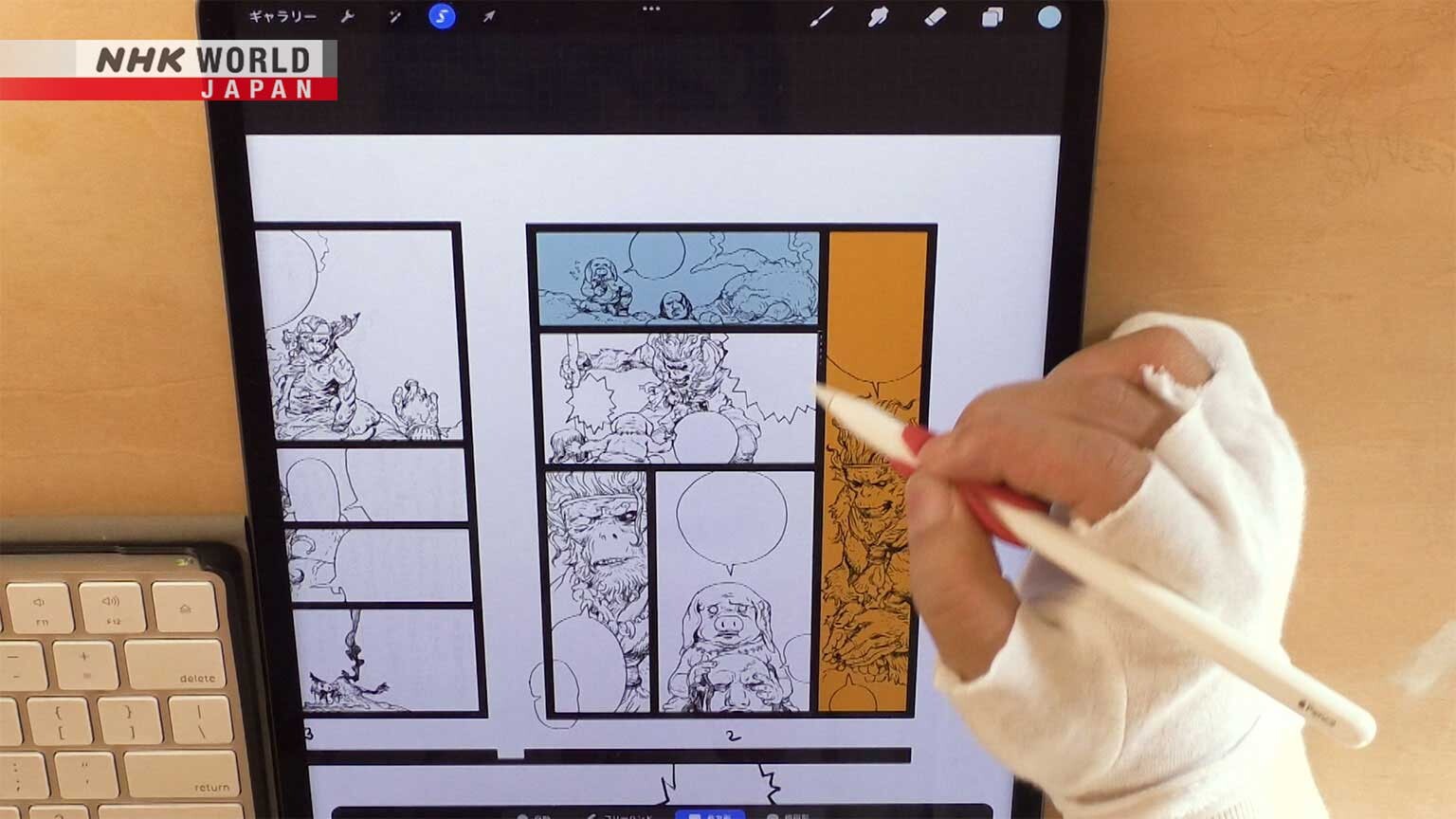
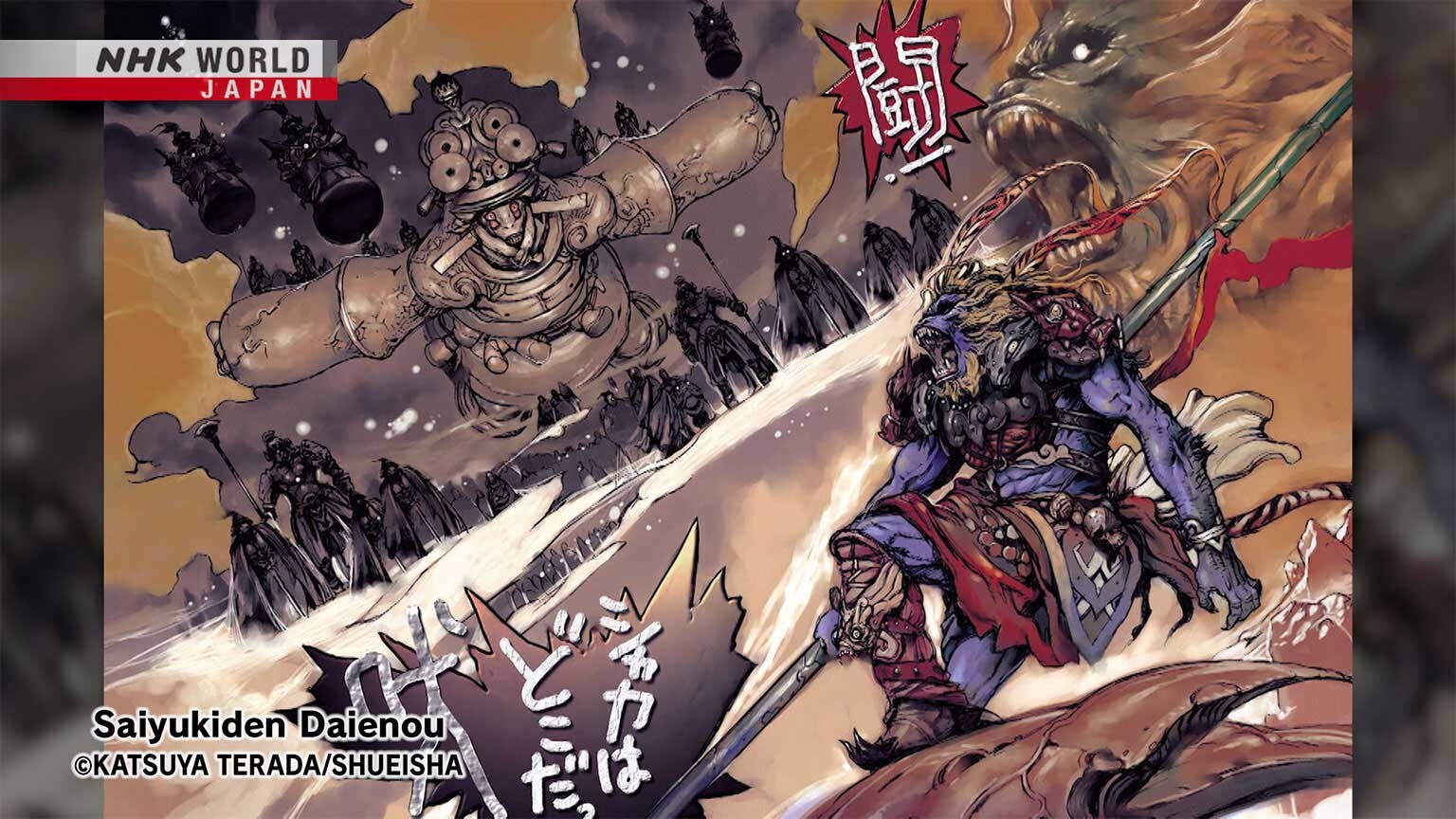
Transcript
You know how it's fun to sing when you get drunk?
I feel that way about Terada.
For him, drawing is more of an inherent act
instead of a fun activity.
Like breathing.
Manga - where drama is created with just the tip of a pen.
In this program, we take you behind the scenes of where manga is made and explore the craft.
The idea came from Urasawa Naoki.
The famous manga artist has released hits in a variety of genres.
Our guest is Terada Katsuya, a successful manga artist and illustrator.
His art is truly one-of-a-kind.
One look and you won't be able to forget Terada's unique worlds and intricate linework.
Many books with his illustrations and sketches have been published.
Numerous authors and filmmakers have fallen in love with Terada's art.
Terada is most known for designing video game characters.
A lot of his fans are outside of Japan.
To many fans, Terada is known as the "Rakuga-King,"
a mix of the Japanese word for doodle, rakugaki, and king.
The moments I love drawing the most are when I feel completely free to doodle.
I try to fill my work with as many of those moments as possible.
One of the works Terada is famous for is Saiyukiden Daienou.
It's an adaptation of the classic Chinese novel known as Journey to the West in English speaking countries.
The story follows Goku and his group.
As they travel, a variety of monsters get in their way.
The full-color action is a perfect example of the worlds Terada creates.
Although the series has already finished its serialized run,
the third and final volume has been unreleased for over 10 years.
Fans around the world have been waiting to find out what's next.
Surprisingly, our program pushed Terada to get back to work,
and he let us film him work on Daienou.
The conversation takes place in an area Terada has lived for over 20 years.
Hello everyone.
I'm sure you all have doodled before.
That's how most manga artists begin.
Our guest today is an artist who has been doodling for decades.
Fans worldwide consider him one of the most skilled artists around.
He's known as "Rakuga-King" for a reason.
Let's go greet the king.
I see him daily, by the way.
The two meet at a gyoza restaurant Terada frequents.
Drinking already?
Not at all.
No drinks here.
We're going sober today.
I'm looking forward to a relaxed talk.
Me, too.
The two move to the back of the restaurant.
Urasawa and Terada have over 10 years of history together, so they have much to discuss.
Terada works in a quiet residential area.
We placed four cameras in his workspace-
-making sure to not disturb his process.
Terada has worked with digital tools for over 20 years.
He uses an ordinary tablet.
The pen has a grip used for pencil training.
Terada says the grip makes it easier for him to use the thin tablet pen.
His workbench is a handmade drawing plate placed on top of a drawer.
It has a very handcrafted look.
Terada draws while standing up.
You work standing?
I used to sit.
But at live art events,
I would draw standing for eight hours straight.
It felt better than sitting.
Why do you wear shoes?
The wooden floor gets cold.
I see.
Terada's eyes look toward the manga's script.
Before he begins to draw, Terada writes out the story beats and lines.
He calls this the "scriptboard."
His focus was on this part.
Inside the dragon, Sanzo chants a mantra, causing the dragon to break open.
Through the gap, they see their destination, Tenjiku.
Sagojo says, "Goku! It's Tenjiku!"
"Whoa!!!"
What will this look like on page?
Do you always write a script?
Lately, yes.
I'm able to deceive myself with words.
- What?
- I tend to cut corners.
I see!
It stops you from taking the easy road?
Yes. I wanted to raise the bar,
so I try to write the scriptboard
from the perspective of a writer
who knows nothing about drawing.
First up, storyboarding.
This is where Terada turns his scriptboard into imagery.
He creates a single horizontal line and begins.
He goes straight to drawing without any rough drafts.
I love the sound.
Is this a pencil tool?
- It's a brush.
- Oh?
Yes. It's more brush-like and fades.
This is just the draft,
so a bit of fade feels the best to use.
I use the pencil tool for inking.
Terada lays down coarse brush strokes without any hesitation.
Is this a dragon?
It looks like the eyes are below the mouth...
The dragon is bending in pain.
In moments, a complex image comes together.
Perfect. You're done.
I agree.
After adjusting size and position, Terada is done with the first panel in no time.
Next, Terada draws three vertical lines.
We finally get to see the panel layout.
In this scene, Sagojo calls out to Goku.
How do you decide panel layout?
I don't think about the content.
You just draw lines?
I start with layouts I find interesting
then work from there.
I love drawing inside of panels.
I even draw borders on illustrations.
I know I can always redo it
if it doesn't look good.
I draw, and if it fits, I go with it.
I don't have a clear vision of the end.
I just know the direction I'm going.
As long as the page feels right,
I can move to the following panels.
Who knew you could create manga panels without knowing what will be inside?
Quite a unique way of storytelling.
Terada revises the script as he draws.
It looks like he'll be changing some of Sagojo's lines.
Terada continues to work without any hesitation.
The storyboard is complete in just 19 minutes -
incredible speed considering Terada decides it all on the fly.
The dragon recoils in agony as its body breaks down from Sanzo's mantra.
Goku and the others struggle to escape the dragon's body.
Even at this early stage, the imagery is packed with action.
Next up is inking.
Terada chooses to use a thick and sharp pencil tool.
He traces over the newly complete storyboard, using it as a rough draft.
If I'm too deliberate,
my lines feel lifeless.
Digital tools let me take a rough draft
and turn it into the final product.
That's one of the main reasons
I work digitally.
Terada tends to get nervous when inking images.
Digital tools make it easy to change lines afterwards, which allows for a rougher touch to the art.
Compared to the storyboard process, Terada works with more precision, layering lines and dots.
Short lines and dots come together
to make the final image.
This is the fun part.
I agree.
Terada starts to whistle.
He must be having a fun time.
The dragon's rugged look becomes more pronounced as the scales are completed.
Terada adds clouds to the background.
In 14 minutes, he completes inking the dragon as it recoils in pain.
Layered lines add three-dimensionality while the clouds emphasize the dragon's massive size.
Next up is the main character, Goku, in a scene where he finally awakens.
Terada changes to a brush tool for this part.
For this panel, he's going with thicker lines than usual.
Did you make the lines thicker?
It's the same brush tool
I used for the storyboard.
Perfect.
I'm going with a graphical approach.
Terada searches for lines that fit each panel.
This is what makes your works special.
You go straight for solid blacks.
I love solids.
It's already done in your head.
Terada makes Goku's eyes solid black.
He uses the brush tool without worrying about rough edges.
I love the gums!
Gums are great.
With a small white spot!
They need to look like gums.
Being able to decide
what something looks like is important.
The "ability to judge."
Different people see different things.
And if you look under the left eye,
you can see some extra ink.
Probably because you moved so fast.
But you left it in.
Yes, why not?
It's all about what you see as you draw.
I think artistic talent is based on
being able to judge what things look like.
Your hand does the work,
and your brain says, "Looks okay."
And that happens instantly for you.
That, and a lot of repetition.
You end up building a library of tricks.
The ability to take random lines and make them look like something to the viewer is key for Terada.
He finishes inking this page in 45 minutes.
Terada meticulously draws the colossal dragon with a pencil tool.
Goku, on the other hand, is drawn with bold strokes from the brush tool.
Comparing it to the storyboard...
You can see how Terada's bold use of different lines creates a page full of dynamic action.
Terada was born in 1963 as the youngest of three children.
He has always loved to draw.
Terada grew up reading manga by Leiji Matsumoto and Yokoyama Mitsuteru.
In middle school, one manga blew Terada away.
The manga was Otomo Katsuhiro's "Space Patrol Shigema."
"Shigema" was your introduction.
Space Patrol Shigema is one of Otomo Katsuhiro's early short stories.
A group of young men gather at a New Year party and confess their secrets.
The strange story ends with one friend calling a UFO from the ocean.
Put bluntly, it was bogus.
The ending, the storyline, the characters. Everything.
But I'll never forget the art.
It showed me that any manga could work with realistic art.
"Shigema" showed me it was okay to break things down
and view the world in your own way.
It really saved me.
I feel that Otomo was able to appeal directly to us and ask,
"Have you ever seen things from this perspective?"
Terada attended a high school for design to work on his artistic ability.
He made his debut as an illustrator and manga artist in his early 20s.
Readers quickly took notice of Terada's crisp artistic style.
His unique illustrations were used in novels, helping more people discover his work.
Terada also puts his artistic skill to full use during live drawing events.
His artwork leaves attendees from around the world in awe.
People always ask if I know what I'm drawing beforehand.
And, honestly, it's hard to answer.
Sometimes I don't.
Sometimes it comes into view as I draw.
It's like I'm following a map.
At places I recognize, I move fast.
At new locations, I take my time,
carefully looking at the map as I go.
One of Terada's live drawings left Urasawa speechless.
I think it was in here.
Got it. The longhorn beetle.
You drew without any references?
Right. I do it all live.
Did you practice beforehand?
No, but when I was young,
it was my favorite bug.
I see!
I used to catch and look at them.
Of course, there are a lot of mistakes.
But it feels right.
It's all about the feel.
I think there's a skill
for understanding structure.
Most living things share
a physical structure.
I can visualize it in my mind.
Like the exoskeleton and muscles.
- This is very impressive.
- Really?
When Terada sketches objects, he makes sure to observe structure.
He uses the vast ideas he gets from these doodles to come up with characters, monsters, and other things.
Terada is very skilled at creating things not of this world,
which is one reason why he's hired to make character designs.
Daienou features unique monsters that appear one after another.
I already have a solid methodology for creating monsters.
Once you have an idea of what to do and decide the initial settings,
then it's just making yes/no decisions.
Like, "Will the character's hand transform into something else?"
That creates two paths.
One way leads to something new.
The other goes in a direction I already find interesting.
It's all quite effortless.
Basically, I have built up a visual vocabulary.
I think that's why I'm suited for character design work.
Especially monsters.
Once again, back to the drawing process.
We were able to catch Terada come up with a brand-new monster.
In the mountains, Goku and his group encounter a friendly-looking older man.
However, the old man turns into a monster!
This is how it looks in the storyboard.
Terada adds details to the rough storyboard.
He makes sure to include the old man's physical characteristics.
More surprising than the speed at which he works is that he improvises the process.
Do you enjoy this part?
This is basically my way of life.
As natural as breathing.
That natural?
Completely.
Would you say you take familiar tasks
and make them feel brand new?
Yes. I don't like drawing the same things.
Even if the images are similar,
I try to add different things.
In this case, I made hoof-like hands.
Things not in the storyboard.
It's all part of how I create
different variations of characters.
If it doesn't feel new, it's not fun.
I agree.
When you draw the same things,
you begin to lose interest.
The young boy inside me won't allow it.
"Drawing the same thing AGAIN!?"
That kid is strict!
I know.
Worse than any editor I've ever met!
When I draw older characters, I can hear,
"There you go, drawing the same people."
It's rough.
The harshest critic.
Terada continues to work without stopping.
In just nine minutes, the inking process is complete.
Starting from a very rough storyboard-
-Terada has created a truly one-of-a-kind monster.
Blood vessels protrude as the mouth opens wide.
The gentle-looking old man has undergone a terrifying transformation.
The next large panel features the mountain turning into a dragon and swallowing Goku and his group.
Here's the storyboard.
All you can see is the mouth.
Terada plans for this scene to come after the old man's transformation.
He starts with the dragon's mouth.
Terada deliberately draws the dragon's crooked teeth one by one.
When it comes down to it, we draw fiction.
But they need to look convincing.
That's right.
Readers notice lines that lack confidence.
But your lines are already finalized.
You know how it will look.
That might be the secret to your work.
Your art shows no hesitation.
In reality, all I do is hesitate, though.
Terada moves on to the dragon's skin.
It's almost as if you can reach out and feel its rugged texture.
Next, mountains in the distance.
Terada changes up his style a bit.
The foreground and the background.
And the desert.
Yes! And the up-and-down terrain.
- I love it.
- Just a few lines are all you need.
Terada zooms in to draw Goku and his group being swallowed by the dragon.
The monster from earlier is there, too, connected to the tentacles.
Your art has crude and grotesque aspects.
But it's never vulgar.
Thank you!
I apologize for being a refined human being!
But to me, being refined or vulgar isn't the point.
I think it's about charm.
Closer to humor.
It helps you create compelling characters.
It's all about capturing the charm.
It is very important
that I like what I'm creating.
Making characters like that is key.
I agree.
My theme.
Terada finishes inking Sagojo being swallowed.
It took 32 minutes to complete this large panel.
The dragon emerges from the mountain with subtle textures and fine details.
At the same time, Goku and his group are being humorously swallowed up.
This two-page spread delivers a captivating visual experience full of Terada's artistic charm.
Another artist has significantly influenced Terada's art.
Moebius, the world-famous sci-fi cartoonist.
His distinctive style, characterized by intricate lines and dots, has made a major impact on Japanese manga.
When did you discover Moebius?
It was in "SF Magazine."
I was about 15 years old and still in middle school.
There was a section about sci-fi art.
One person wrote, "There's an amazing cartoonist in France."
It was just a two-color page, but it featured art by Moebius.
It took my breath away.
Terada went on to buy every magazine featuring Moebius he could find.
This image particularly left a mark.
The character's eyes use single lines.
They're actually the bone above the eyes.
And the little guy playing keeper
with a strange machine.
I was completely sucked into that one panel.
Plus, the linework.
It's like I had this unspoken rule
that lines for manga and illustrations were two different things.
But Moebius used the same lines in both his illustrations and panel art.
My manga felt so dull compared to my illustrations.
But I could just use illustration lines in manga.
That's when everything changed for me.
Urasawa was also deeply impacted by Moebius' art as a university student.
For me, it was "STARLOG."
There was a small feature about Moebius.
I saw his work and thought,
"That's my art!"
I knew that's where I wanted to go.
It's not just about delicate linework.
It's about using convincing lines
to build substance.
Each line comes together
to create a truly fascinating image.
I told Moebius directly
that I copy his techniques.
Me, too.
Moebius expressed the "world" by meticulously layering detailed lines.
Drawing inspiration from Moebius, Terada developed his own artistic style.
Day three.
Terada adds color to the page.
Terada minimizes the pages he drew and arranges them across the screen.
He begins to fill in each panel with a color.
You first decide colors for each panel.
That's right.
How does Terada choose a base color for each panel?
I choose colors to represent story beats.
Instead of going for a realistic look,
I aim for an expressionistic approach.
For surprise, turn everything red.
Light can also change colors.
I'm always exploring what colors say
or what emotions they evoke.
Terada changes colors for each panel like changing lighting in a film.
After deciding base colors, he moves on to details.
For the panel of the old man transforming into a monster, Terada starts with purple.
Using a brush tool that adds chalk-like texture, he gradually applies color.
For the legs, Terada goes with a bold red.
How does he decide to color his creations?
Basically, there's no correct answer.
Once I'm done, that becomes the answer.
As the old man yells out and transforms,
I added red to enhance the effect.
Although he's not bleeding,
red felt like the right emotion.
Once I added it, I knew I was right.
Terada loves to improvise, even with color.
He highlights the eyes with a dangerous, yellow glow.
And finishes with some highlights.
White spots give the image a three-dimensional feel.
It took Terada 22 minutes to complete this panel.
In full color, the monster looks even more alive than before.
While the inked image is impressive enough, adding color gives it an ominous feel.
What colors will Terada use for the two-page spread?
He chooses green for the mountainside and orange for the dragon.
Terada then adds a vivid red.
The inside of the mouth is light blue.
So colorful!
If you colored the dragon like Godzilla,
it would be too boring.
Yes.
I thought red would be a good match.
But as I colored, I felt it needed more.
Since the scenery had lots of warm colors,
I used blue for the falling parts.
That's my thought process.
Terada colors the tentacles around Goku red.
The tentacles are actually coming out of the old man.
The old man came out looking very weak.
He wasn't strong enough on his own.
So, I made him part of the dragon.
Like the dorsal spine of an angler fish.
I added long tubes inside the dragon.
They could be blood vessels, whiskers,
a tongue, or whatever else.
The goal was to make it look like
it was all connected and moved together.
It turns out the old man was a part of the dragon!
Even when improvising, Terada's attention to detail is incredible.
Next, he adds depth to the dragon with dark gray shadows.
When working on color manuscripts,
shadowing is the most enjoyable part.
I agree.
Adding texture with quick dashes.
This is all about perfecting the image.
Shadows come last.
Dabbing in shadows brings it all together.
The world of Daienou comes to life with each dash of color.
Watching you work makes me feel
that art style decides genre.
You wouldn't make a manga like "YAWARA," would you?
I couldn't.
Like you, as a kid, I started with
Tezuka Osamu and Ishinomori Shotaro.
Then, I moved on to Moebius,
Otomo Katsuhiro, and so on.
But one day,
I decided to make a female judo manga "YAWARA."
I turned the wheel in a new direction.
You've always been able to
reach mainstream audiences.
In my case, the boy inside me
is in a small room telling me,
"Draw this!" or "What about this?"
He led me to where I am now.
That child is at the core of any artist.
That's why I'm jealous at your ability
to stay true and dedicated to that boy.
I'm sure a lot of artists feel the same!
They admire how you keep pushing forward.
After layering pale-blue colors on the mountainside, Terada is finished.
Colorful monsters not of this world.
And in the air, Goku and his group in danger.
The colors turn the monotone scene into a vibrant, catchy image.
A big part of my job is illustrating.
I make an illustration, then a manga.
Stretching my hands in both directions helps me maintain balance.
But I have yet to make a manga that satisfies me.
The hope I will keeps me going.
I would love to make a short story.
Then hand it to you and say, "Make this a manga!"
I want you to try something like that.
A manga?
Yes, and interpret it in a straightforward way.
That's not me. I like angles.
From your perspective, not someone else's!
I see.
We don't have much time left.
I would love to try something like that.
But if not, that's fine, too.
Although they share the same influences, Terada and Urasawa release very different work.
After the discussion, we asked them to do a live sketch of each other.